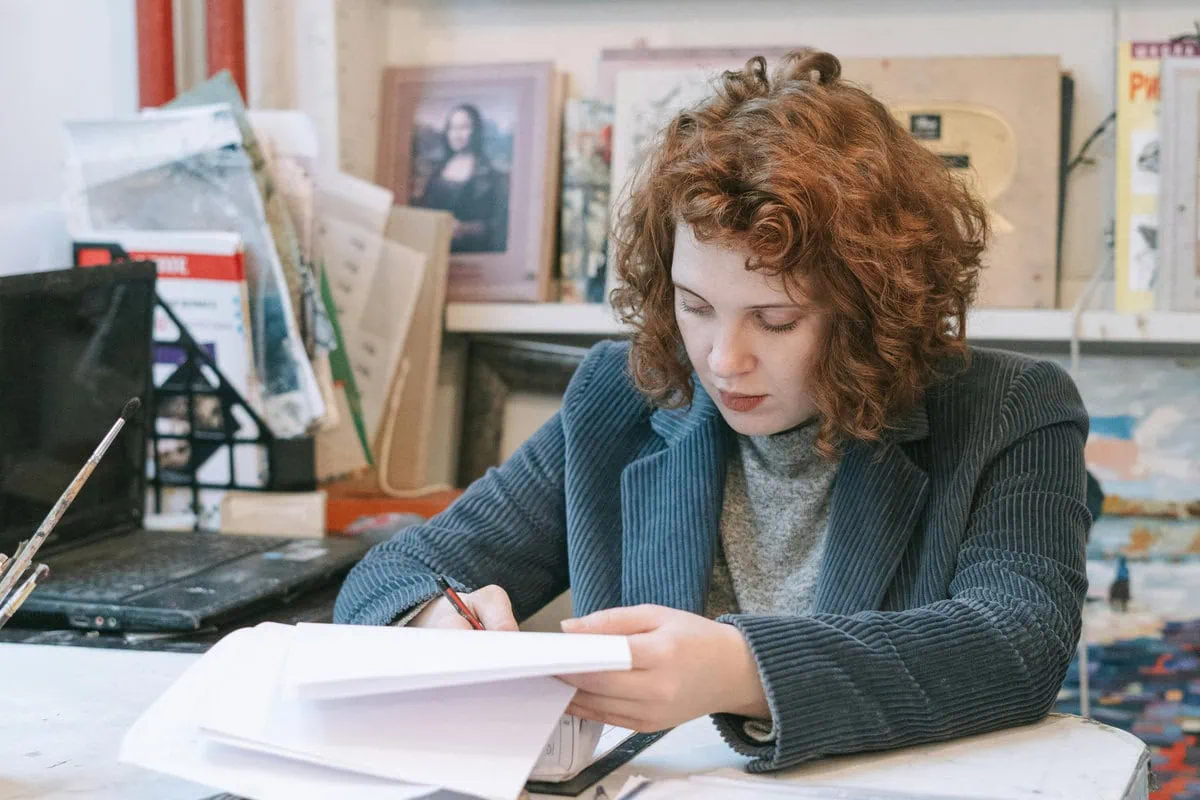Cover image: Ivan Samkov/Pexels.
In this post, I would like to dispel the all-too-common myth that there aren’t many careers in the arts and no jobs for art history majors. That’s not correct at all, and it really bothers me when people say that. Even if you’re not looking for a new career path, you may hear these job titles during your art adventures and wonder what they’re all about. Each requires in-depth knowledge of art and art history, as well as many other skills.
What follows is not a comprehensive list. It only mention a handful of the most interesting jobs among the dozens of positions within arts institutions. It doesn’t include anybody who actually makes art, and it doesn’t take into account all the great jobs out there that use the skills you learn in an art history program but aren’t specifically in the arts field.
Hey guys! Here’s a friendly reminder that this is not career guidance, and you should not base your academic or career decisions on this post. It’s intended for general information only.
Scholars: Curator
A curator works for a museum and usually has an advanced degree in art history. As the name suggests, they curate the museum and its exhibitions. This means making decisions about what to acquire and display, how to display it, and how to interpret it for audiences. They also manage the study of the collections and organize special exhibitions. Most museums have more than one curator in different areas of specialty; major museums employ dozens in a hierarchy that includes a chief curator, curators in charge of departments, and many assistant and associate curators. Curators also write books and articles, do research, give lectures, and more. Outside the museum world, a curator may be anyone who curates exhibitions.
Professor
Art history professors are the ultimate experts – people to whom others turn for their educated opinions. They almost always have PhDs. Working for colleges or universities, art history professors teach undergraduate and graduate courses and mentor the next generation. But that’s only part of their job. They also do lots of original research and write academic books and articles in their specialized areas of study.
Researcher
The art industry includes tons of trained art historians who work as researchers in all areas of art. Pretty much any art-related institution and business, as well as some private collections and other endeavors, could potentially employ them to research, record, write catalogs about, and study the provenance of art. There are also independent art historians (like me); that job path is a little different for everyone but generally involves taking on some duties of the curator, researcher, and professor without being employed by a single institution.
Expert guidance for your next art museum adventure

People who care for art: Conservator
Sort of like a doctor or surgeon, a conservator physically cares for artworks, especially old and fragile ones. The job involves healing past damage and stabilizing the art to avoid further decay. But contrary to popular belief, it does not necessarily mean trying to make the art look like new. Conservators need to know a lot about art making, art history, and science in order to understand not just the artist’s techniques and intentions, but also the physical and chemical processes involved in damage and repair. They may even run imaging or scientific tests to better understand how works have been put together. Some major museums have their own conservation labs with conservators on staff, and there are independent labs and studios in private practice as well. This is a really fascinating job, which is probably why museums tend to post lots of videos about it online. Conservators are sometimes also called restorers, but that term isn’t as common anymore.
In case you’re wondering, the architectural equivalent of conservation is historic preservation, the conservation of buildings and other historic monuments. Professionals in this field must be knowledgeable about architecture, engineering, construction, drafting, and various craftsmanship techniques in addition to art and architectural history.
Art handler/Preparator
Art handlers, also known as preparators, are skilled in the best ways to safely move, display, and store art. Since artworks are often large, heavy, fragile, and bulky, this isn’t easy! An art handler might move an artwork from museum storage and install it in an exhibition gallery in the same building, but they might also transport it across the world. They don’t just do heavy lifting; preparators plot every step of the move from creating custom crates and figuring out transport logistics to arranging climate-controlled storage and designing secure installations. They sometimes even travel with the art. Art handlers/preparators usually work in institutions like museums and auction houses, but there are also independent art handling companies who work for both private and institutional clients. Museums sometimes post cool videos about this job, too.
Museum guard
A museum guard typically wears some kind of uniform and watches over museum galleries during visiting hours for the safety of both artworks and patrons. They’re not the same as security guards who work while the museum is closed. Although this job doesn’t sound like it would require art knowledge, a surprising number of museum guards are also artists or have other connections to the arts.
Registrar
Part librarian and part record keeper, a registrar keeps track of all the art owned by an institution or passing through it. In a museum, which can easily own several times the number of works it actually displays, or an auction house, where objects cycle in and out on a regular basis, this is a huge and essential job. Not only do registrars have to know exactly where every object is at all times (on display, in storage, in the conservation lab, out on loan, etc.), they also have to maintain detailed records of every object. These include pertinent details like provenance and condition. Even the smallest museums use collection management software in this process, but it still must be a daunting undertaking.
The Art Market: Appraiser
An appraiser is someone who determines the monetary value of artworks based on the prior sales of similar artworks. This is necessary for insurance, taxes, estates, and more. If you’re familiar with home or car appraisals, the concept is essentially the same, although the same appraiser could not appraise both your house and your art collection. From the subject matter to the provenance to the firmness of the attribution, countless factors can impact art’s value, so appraisers need to really understand the finer points of art history.
Dealer/Gallerist
An art dealer or gallerist is someone who buys and sells art for a living, usually through a gallery and sometimes also online and through art fairs. They may specialize in any type of art, though the majority sell contemporary art and often work closely with the artists themselves. Dealers/gallerists curate exhibitions in their galleries, write publications, forge connections with artists and collectors, and market the works they’re selling. They sometimes also act like agents for living artists they represent. This is a demanding field that requires substantial business acumen in addition to art knowledge, connections, and people skills. “Dealer” and “gallerist” have slightly different connotations; “gallerist” is a much more recent term meant to imply a closer relationship with working artists than the commercial-sounding term “dealer”. However, not everyone agrees that there’s a meaningful difference between the two job titles.
Art advisor
Art advisers help collectors decide which artworks to buy and sell and may also help to facilitate those transactions. They assist in building up and shaping private collections. You can think of art advisers as something like investment advisors who work with art rather than stocks and bonds, but monetary value is only one of many factors they must consider. A good art adviser needs to be knowledgeable about art, well connected, and have good business skills.
Understand the messages that art exhibitions share with their viewers.

More Cool Arts Jobs: Art critic
Typically associated with a newspaper, magazine, or online publication, an art critic reviews current exhibitions and artworks. Similar to movie critics, art critics view new exhibitions and give their opinions about whether they’re worth visiting. They may also comment on new artworks and art-world happenings. Critics who write for major publications like The New York Times are taste-makers with substantial power to advance or hinder exhibition attendance, curators’ reputations, and even artists’ careers. Aside from an experienced eye, strong writing skills, and confidence in your assessments, I really don’t know how someone ascends to the position of art critic.
Art educator
There’s a bunch of different ways to be an art educator. One path is to be a school teacher who teaches art making and appreciation. Art therapists, psychologists or social workers with advanced degrees and special training, use art to help people psychologically and developmentally. Museums also employ educators to design and lead educational programs for children and adults within their galleries and online.
Art insurance, law, finance, publishing, and journalism
In all these jobs, expertise in art and art history can give professionals a specialty.
- Most people who own art want to insure it, so insurance companies who offer art insurance need art-savvy employees.
- The art world also needs specialized lawyers to deal with everything from artists’ rights to provenance disputes to cultural heritage protection issues.
- Some people buy art as an investment, and a small sector of the finance industry has developped around this glamorous but challenging asset class.
- Publishing houses who publish art books need knowledgeable editors, and periodicals employ journalists who specialize in writing about art-related news and issues.
Further reading
- “About Art Therapy”. American Art Therapy Association
- Association of Professional Art Advisors
- Appraisers Association of America
- Art Dealers Association of America
- Baumgartner Restoration YouTube channel
- “The Role of the Art Advisor” Sotheby’s Institute of Art. January 16, 2018.
- Jenny. “Demystifying the Roles: Art Dealer, Gallerist, and Art Advisor” Nomad Salon. June 10, 2023.
- McGreevy, Nora. “Handle with Care: Art Preparators at Work” Princeton University Art Museum.
- Migdol, Erin and Rita Gomez. “What Is an Art Preparator?” Getty News blog. J. Paul Getty Trust. November 11, 2021.
- Migdol, Erin and Lora Chin Derrien, “What Exactly Does a Registrar Do?” Getty News blog. J. Paul Getty Trust. April 4, 2024.



